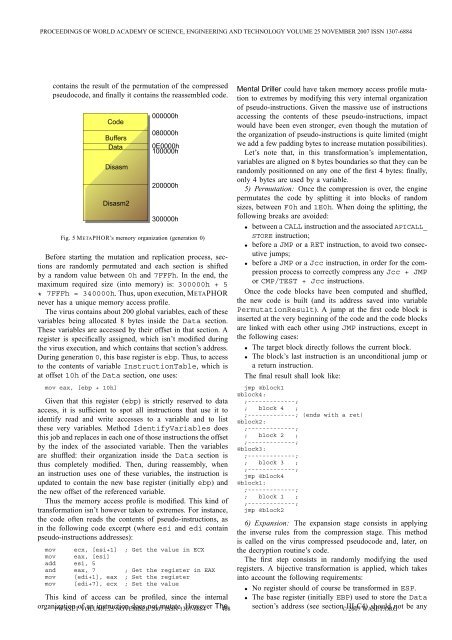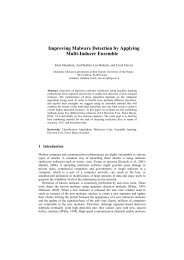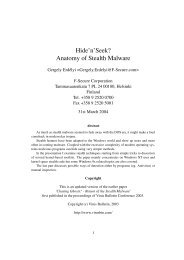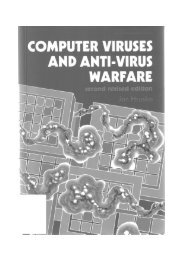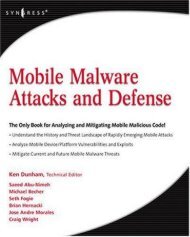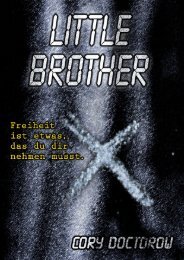Advanced Polymorphic Techniques.pdf - adamas.ai
Advanced Polymorphic Techniques.pdf - adamas.ai
Advanced Polymorphic Techniques.pdf - adamas.ai
You also want an ePaper? Increase the reach of your titles
YUMPU automatically turns print PDFs into web optimized ePapers that Google loves.
PROCEEDINGS OF WORLD ACADEMY OF SCIENCE, ENGINEERING AND TECHNOLOGY VOLUME 25 NOVEMBER 2007 ISSN 1307-6884cont<strong>ai</strong>ns the result of the permutation of the compressedpseudocode, and finally it cont<strong>ai</strong>ns the reassembled code.Fig. 5 METAPHOR’s memory organization (generation 0)Before starting the mutation and replication process, sectionsare randomly permutated and each section is shiftedby a random value between 0h and 7FFFh. In the end, themaximum required size (into memory) is: 300000h + 5* 7FFFh = 340000h. Thus, upon execution, METAPHORnever has a unique memory access profile.The virus cont<strong>ai</strong>ns about 200 global variables, each of thesevariables being allocated 8 bytes inside the Data section.These variables are accessed by their offset in that section. Aregister is specifically assigned, which isn’t modified duringthe virus execution, and which cont<strong>ai</strong>ns that section’s address.During generation 0, this base register is ebp. Thus,toaccessto the contents of variable InstructionTable, whichisat offset 10h of the Data section, one uses:mov eax, [ebp + 10h]Given that this register (ebp) is strictly reserved to dataaccess, it is sufficient to spot all instructions that use it toidentify read and write accesses to a variable and to listthese very variables. Method IdentifyVariables doesthis job and replaces in each one of those instructions the offsetby the index of the associated variable. Then the variablesare shuffled: their organization inside the Data section isthus completely modified. Then, during reassembly, whenan instruction uses one of these variables, the instruction isupdated to cont<strong>ai</strong>n the new base register (initially ebp) andthe new offset of the referenced variable.Thus the memory access profile is modified. This kind oftransformation isn’t however taken to extremes. For instance,the code often reads the contents of pseudo-instructions, asin the following code excerpt (where esi and edi cont<strong>ai</strong>npseudo-instructions addresses):Mental Driller could have taken memory access profile mutationto extremes by modifying this very internal organizationof pseudo-instructions. Given the massive use of instructionsaccessing the contents of these pseudo-instructions, impactwould have been even stronger, even though the mutation ofthe organization of pseudo-instructions is quite limited (mightwe add a few padding bytes to increase mutation possibilities).Let’s note that, in this transformation’s implementation,variables are aligned on 8 bytes boundaries so that they can berandomly positionned on any one of the first 4 bytes: finally,only 4 bytes are used by a variable.5) Permutation: Once the compression is over, the enginepermutates the code by splitting it into blocks of randomsizes, between F0h and 1E0h. When doing the splitting, thefollowing breaks are avoided:• between a CALL instruction and the associated APICALL_STORE instruction;• before a JMP or a RET instruction, to avoid two consecutivejumps;• before a JMP or a Jcc instruction, in order for the compressionprocess to correctly compress any Jcc + JMPor CMP/TEST + Jcc instructions.Once the code blocks have been computed and shuffled,the new code is built (and its address saved into variablePermutationResult). A jump at the first code block isinserted at the very beginning of the code and the code blocksare linked with each other using JMP instructions, except inthe following cases:• The target block directly follows the current block.• The block’s last instruction is an unconditional jump ora return instruction.The final result shall look like:jmp @block1@block4:;-------------;; block 4 ;;-------------; (ends with a ret)@block2:;-------------;; block 2 ;;-------------;@block3:;-------------;; block 3 ;;-------------;jmp @block4@block1:;-------------;; block 1 ;;-------------;jmp @block26) Expansion: The expansion stage consists in applyingthe inverse rules from the compression stage. This methodis called on the virus compressed pseudocode and, later, onmov ecx, [esi+1] ; Get the value in ECX the decryption routine’s code.mov eax, [esi]The first step consists in randomly modifying the usedadd esi, 5and eax, 7 ; Get the register in EAX registers. A bijective transformation is applied, which takesmov [edi+1], eax ; Set the registerinto account the following requirements:mov [edi+7], ecx ; Set the value• No register should of course be transformed in ESP.This kind of access can be profiled, since the internal • The base register (initially EBP) usedtostoretheDataorganization PWASET of VOLUME an instruction 25 NOVEMBER does not 2007 mutate. ISSN 1307-6884 However The 408 section’s address (see section© III-C4) 2007 WASET.ORG should not be any


